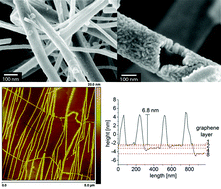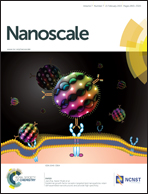Non-destructive functionalisation for atomic layer deposition of metal oxides on carbon nanotubes: effect of linking agents and defects†
Abstract
The hybridisation of metal oxides and nanocarbons has created a promising new class of functional materials for environmental and sustainable energy applications. The performance of such hybrids can be further improved by rationally designing interfaces and morphologies. Atomic layer deposition (ALD) is among the most powerful techniques for the controlled deposition of inorganic compounds, due to its ability to form conformal coatings on porous substrates at low temperatures with high surface sensitivity and atomic control of film thickness. The hydrophobic nature of the nanocarbon surface has so far limited the applicability of ALD on CNTs. Herein we investigate the role of structural defects in CNTs, both intrinsic and induced by acid treatment, on coverage, uniformity and crystallinity of ZnO coatings. Furthermore, we demonstrate the potential of small aromatic molecules, including benzyl alcohol (BA), naphthalene carboxylic acid (NA) and pyrene carboxylic acid (PCA), as active nucleation sites and linking agents. Importantly, only PCA exhibits sufficiently strong interactions with the pristine CNT surface to withstand desorption under reaction conditions. Thus, PCA enables a versatile and non-destructive alternative route for the deposition of highly uniform metal oxide coatings onto pristine CNTs via ALD over a wide temperature range and without the typical surface corrosion induced by covalent functionalisation. Importantly, preliminary tests demonstrated that the improved morphology obtained with PCA has indeed considerably increased the hybrid's photocatalytic activity towards hydrogen evolution via sacrificial water splitting. The concept demonstrated in this work is transferable to a wide range of other inorganic compounds including metal oxides, metal (oxy)nitrides and metal chalcogenides on a variety of nanocarbons.


 Please wait while we load your content...
Please wait while we load your content...